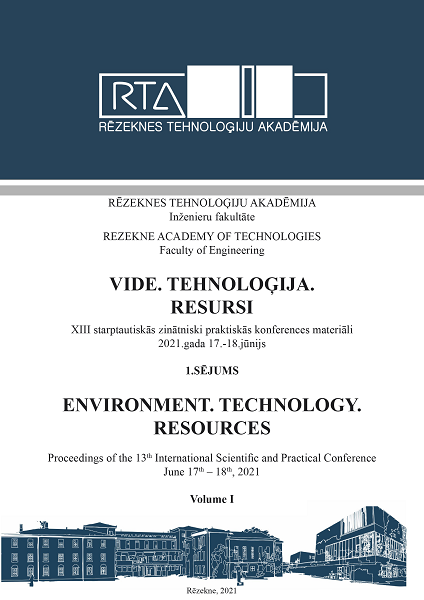IMPACT OF CULTIVATION TECHNOLOGIES ON SOYBEAN PRODUCTION AND QUALITY
DOI:
https://doi.org/10.17770/etr2021vol1.6605Keywords:
soybean, feed, food, fertilisation, proteinAbstract
Legumes are considered the second most important food source after cereals. One of high protein legume – soybeans is new species for growing in Latvia. Biochemical composition of soybeans is variable dependent on varieties, and highly affected by environmental factors, including fertilisation and the presence of Rhizobium bacteria. Therefore, the present study was conducted to evaluate a chemical composition of soya (Glycine max L) differently fertilized and grown in different places in Latvia. In this study was evaluated protein, fat, fibre content and yield of soybean variety ’Laulema’ grown at different (F1-F6) fertilisation background in Stende and Vilani. Overall results of a three-year analysis (2018-2020) showed that the protein content of soybean ‘Laulema’ ranged from 31.0 to 38.9%, values of total crude fat ranged from 19.4 to 22.4, but crude fibre 10.5-13.7%. Significant difference was observed among fertilisation background, year and climatic conditions. Soybean productivity depends to a large extent on climatic conditions. Providing favourable conditions for the development of Rhizobium bacteria and the availability of balanced nutrients for plants, soybean yield can reach 2 - 3 t ha-2 also in Latvia
Downloads
References
EIP AGRI report, 2014.
Eurostat, 2019.[online] Available :
https://ec.europa.eu/eip/agriculture/en/publications/eip-agri-focus-group-protein-crops-final-report
C. M. Grieshop and G. C. Fahey. “Comparison of quality characteristics of soybean meals,” J. Agric. Food Chem., vol. 60, pp. 437–442, 2001.
C. M. Grieshop, C. T. Kadzere., G. M. Clapper, E. A. Flickinger, L. L. Bauer, R. L. Frazier and G. C. Fahey Jr.. “Chemical and nutritional characteristics of United States soybeans and soybean meals,” J. Agric. Food.Chem., vol. 51, pp.7684–7691, 2003.
J. Board and C. S. Kahlon , Soybean yield formation: What controls it and how it can be improved in Soybean Physiology and Biochemistry, pp. 1-36, November, 2011.
https://www.researchgate.net/publication/221918892_Soybean_Yield_Formation_What_Controls_It_and_How_It_Can_Be_Improved [Acessed Marth 20, 2021] DOI: 10.5772/17596
ISO 5498:1981. Agricultural food products. Determination of crude fibre content. ISO/TC34, ICS: 67.050, ed.1, 8 pp.
A. M. H. de Avila., J. R. B. Farias, H. S. Pinto, F. G. Pilau, “Clmatic restrictions for maximizing soybean yields,” in A comprehensive Survey of International Soybean Research- Genetics, Physiology, Agronomy and Nitrogen Relationships pp.367-375, January 2, 2013. eBook (PDF) ISBN: 978-953-51-4259-1.
https://www.intechopen.com/books/a-comprehensive-survey-of-international-soybean-research-genetics-physiology-agronomy-and-nitrogen-relationships/climatic-restrictions-for-maximizing-soybean-yields [Acessed Marth 20, 2021]
V. Popovic, M.Tatič, V. Sikora, J. Ikanovic, G. Drazic, V.Dukiċ, B. Mihailovic, V. Filipovic, G.Dozet, L. Jovanovic and P. Stevanovic “Variability of yield and chemical composition in soybean genotypes grown under different agroecological conditions of Serbia” Romanian Agr.Res., No 33, pp. 29-39, 2016.
M. Bednarczyk, I. Pisarek “Sustainable development for soya production based on the field research carried out at the Variety assessment experimental station of Glubczyce in the years 2015-2017”, Economic and Environmental Studies, vol 18, no 4., pp.1219-1234, April 2019,
https://www.researchgate.net/publication/332555939 [Acessed Marth 20, 2020]
DOI: https://doi.org/10.25167/ees.2018.48.3
R. M. Morshed, M. M. Rahman and M.A.Rahman “Effect of nitrogen on seed yield, protein content and nutrient uptake of soybean (Glycine max L.),” J.Agric Rural Dev, vol. 6 (1&2), pp.13-17, June 2008. http://www.banglajol.info/index.php/jard [Accessed Marth 15, 2021] DOI: 10.3329/jard.v6i1.1652
D. Bobrecka-Jamro, W. Jarecki and J. Buczek ”Response of soya bean to different nitrogen fertilization levels,” J. Elem., vol. 23 (2), pp. 559-568, 2018. Ūtiski DOI: 10.5601/jelem.2017.22.3.1435
J.Vollmann, C. N. Fritz, H. Wagentristi and P. Ruckenbauer “Environmental and genetic variation of soybean seed protein content under Central European growing condtions” J. Sci. Food Agric. Vol 80, pp.1300-1306, 2000.
A. S. Ferreira, A.A., Balbinot Jr., F. Werner, C. Zucareli, J. C. Franchini and H.Debiasi “Plant density and mineral nitrogen fertilization influencing yield, yield components and concentration of oil and protein in soybean grains,” Bragantia vol.75 (3), pp. 362-370, June 23, 2016.
https://www.scielo.br/scielo.php?script=sci_arttext&pid=S0006-87052016000300362 [Acessed Marth 20, 2021]
https://doi.org/10.1590/1678-4499.479
M. Valinejad, S. Vaseghi, and M. Apzali, “Starter nitrogen fertilizer impact on soybean yield and quality,”int. J. Eng. Adv. Tech., vol. 3(1), pp.333-337, October2013. https://www.ijeat.org/wp-content/uploads/papers/v3i1/A2250103113.pdf
USDA (2018) United States Department of Agriculture Food Composition Databases. [Online]. Available:
https://www.nal.usda.gov/fnic/databases. [Acessed 30.04.2020.]


